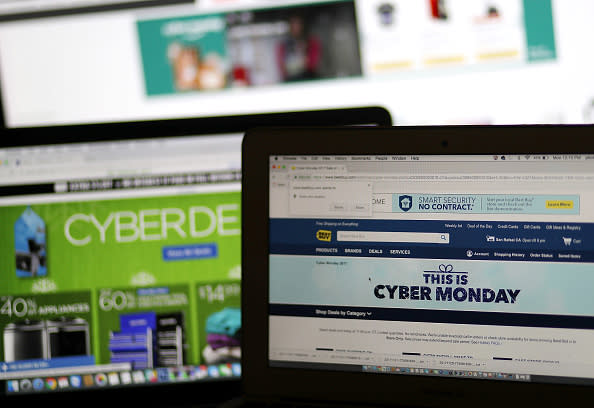Cyber Monday Hits Record as Discounts Drive Sales

Shoppers logged in to set Cyber Monday records — but the digital rush continued what’s become the dominant holiday theme as merchants offered up big discounts to entice spending.
Adobe Analytics found U.S. e-commerce shoppers spent $11.3 billion on Monday, 5.8 percent growth from a year earlier.
More from WWD
That boiled down to $12.8 million a minute and the biggest digital shopping day ever — a mark that clearly required some extra incentive from sellers, which came into the holiday season with lots of inventory given the COVID-19 supply chain backups and the economically challenged shopper.
“With oversupply and a softening consumer spending environment, retailers made the right call this season to drive demand through heavy discounting,” said Vivek Pandya, lead analyst at Adobe Digital Insights. “It spurred online spending to levels that were higher than expected, and reinforced e-commerce as a major channel to drive volume and capture consumer interest.”
Many fashion brands spent the pandemic focusing on their best customers, swearing off price promotions in a bid to drive profit margins with a more sustainable base. However, that resolve is being tested as the trend ran straight into supply chain troubles that had apparel brands spending more to keep core styles in stock.
And fashion has plenty of competition from other categories.
The online push on Monday was driven by toys, which saw sales spike 684 percent compared to an average day in October 2022, according to Adobe, which also saw gains in electronics (up 391 percent), books (up 439 percent) and jewelry (up 410 percent).
From Thanksgiving through Cyber Monday, U.S. shoppers spent $35.3 billion online, a 4 percent increase, Adobe said.

At Shopify Inc., which manages the e-commerce infrastructure of millions of independent businesses globally, apparel and accessories did surge to the fore and was the top category from Black Friday to Cyber Monday, when the platform processed $7.5 billion in sales, a 19 percent increase.
Health and beauty and home and garden were also top-performing categories on Shopify, with shoppers in London, New York and Los Angeles ranking as the most active buyers.
Cyber Monday got its start when people used to wait until they were at work after the long weekend, using their bosses’ faster internet connections to nab online holiday deals.
Now the day has become another milestone on a holiday calendar that starts before Halloween and stretches on until after Christmas as people head back to stores and e-commerce sites with gift cards and returns.
Shoppers have also become increasingly comfortable shifting back between stores and websites as they look to get their holiday business done.
The National Retail Federation said a record 196.7 million Americans shopped stores and online during the five-day Thanksgiving to Cyber Monday period, supporting expectations for a 6 to 8 percent nominal sales gain for the holiday season.
The NRF, in conjunction with Prosper Insights & Analytics, on Tuesday released findings from a survey of 3,326 adults indicating U.S. consumers spent an average of $325.44 on holiday-related purchases over the five-day stretch, up from $301.27 in 2021. Of that amount, $229.21 was specifically spent on gifts.
The NRF predicts total sales of between $942.6 billion and $960.4 billion for the holiday season, defined as the Nov. 1 to Dec. 31 period.
Matt Shay, NRF’s president and chief executive officer, said 2022 has been an “unpredictable year and very different from the last two holiday seasons” with retailers dealing with a number of headwinds, including inflation and the tight labor market.
“It is important to note that while some may claim that retail sales gains are the result of higher prices, they must acknowledge the historic growth in consumers who are shopping in-store and online during the long Thanksgiving holiday weekend and into Cyber Monday. It is consumer demand that is driving growth,” Shay said.
Consumers are about halfway done with their holiday gift shopping, he said.
“It’s clear American households are a bit more cautious with spending though they continue to spend on necessities,” Shay said. “The ability to spend has been supported by job growth, rising wages and with some households taking on additional debt or tapping into savings to meet those monthly expenses.”
Spending power has been sapped by inflation, which Russia’s invasion of Ukraine and the pandemic have helped push to 40-year highs, increasing at a year-over-year clip of 7.7 percent in October.
All together, sales from the long holiday weekend and Cyber Monday suggest that Christmas is indeed going to come this year, but that the season is being colored by an increasingly unsure shopper.
Where consumers last year were rushing out to buy and feeling ready to celebrate, people are now pulling back in a changed world, with a recession in the offing as macroeconomic forces play out.
The Conference Board’s November reading of its Consumer Confidence Index slid to 100.2 on Tuesday, down from 102.2 in October.
“Consumer confidence declined again in November, most likely prompted by the recent rise in gas prices,” said Lynn Franco, senior director of economic indicators at the research group and think tank. “The Present Situation Index moderated further and continues to suggest the economy has lost momentum as the year winds down. Consumers’ expectations regarding the short-term outlook remained gloomy.
“Inflation expectations increased to their highest level since July, with both gas and food prices as the main culprits,” Franco said. “Intentions to purchase homes, automobiles and big-ticket appliances all cooled. The combination of inflation and interest rate hikes will continue to pose challenges to confidence and economic growth into early 2023.”
That means the holiday season — even if it’s lackluster by relative standards — could also be retail’s last hurrah for a while.

